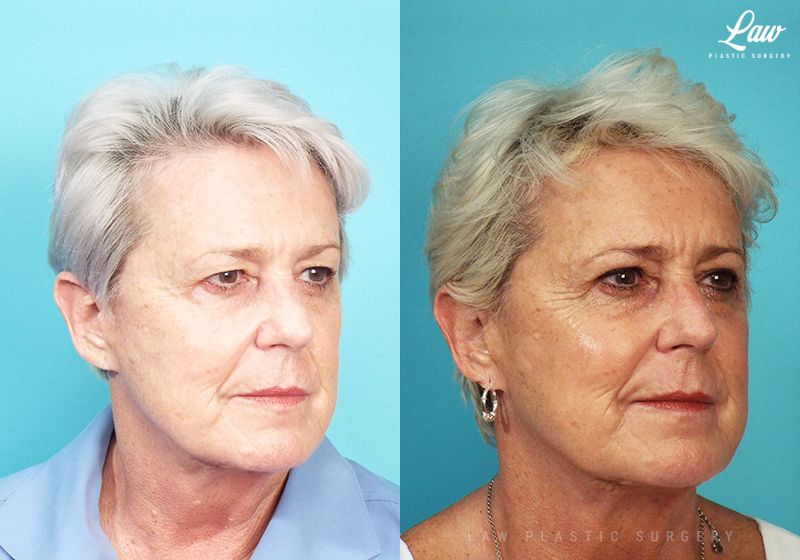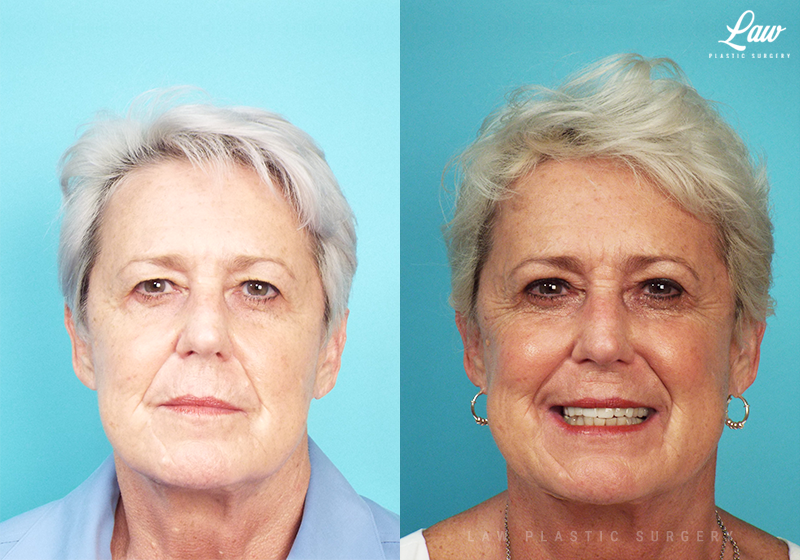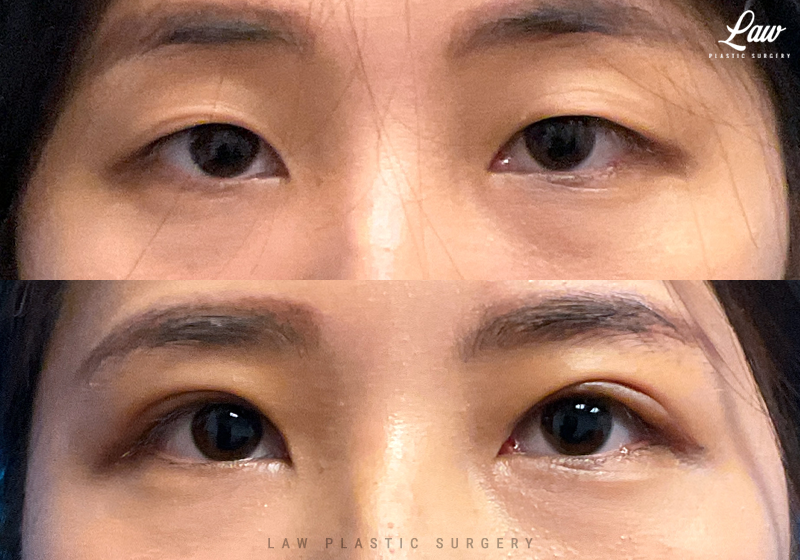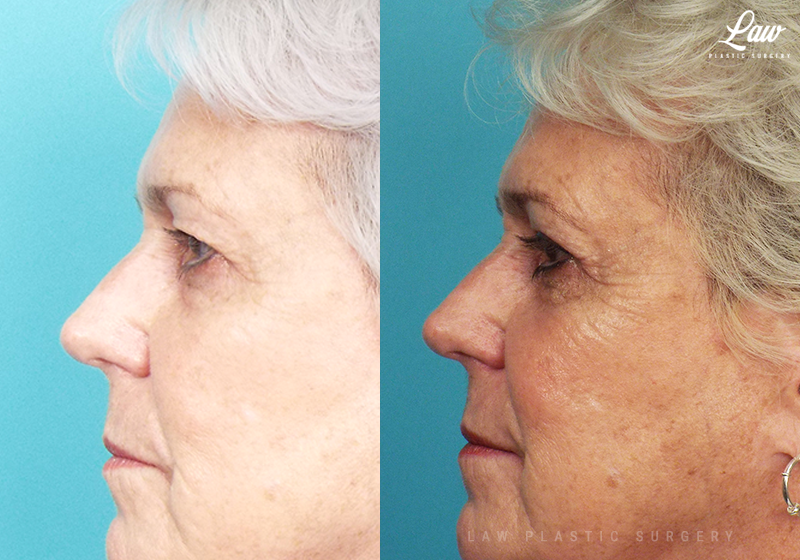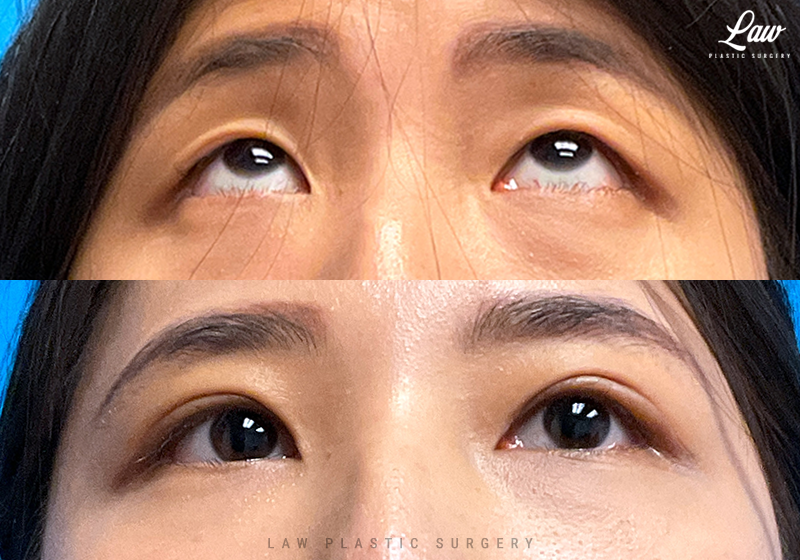Download Your Surgery Guide.
Dallas Eyelid Surgery (Blepharoplasty) Specalist
With eyelid surgery (aka an eyelid lift, an eye lift or a blepharoplasty), a facial plastic surgeon can resolve a variety of eyelid issues. Functional issues (e.g., drooping of the upper and lower eyelids) as well as rejuvenate the appearance of the eyes (e.g., puffy-looking eyes). At Law Plastic Surgery in Dallas, Dr. Huay-Zong Law, who is a highly experienced, board-certified facial plastic surgeon, performs upper and lower blepharoplasty procedures. Dr. Law dedicates himself to providing these patients with the highly functional, refreshed and more-youthful looking eyes they desire.
Why Would Someone in Dallas Choose to Have Eyelid Surgery?
Men and women in the Dallas area choose to have a blepharoplasty to address lower eyelids that sag, appear dark or puffy and to resolve drooping, bloated-looking upper eyelids. Although Dr. Huay-Zong Law frequently performs upper and lower blepharoplasty procedures to help patients attain the refreshed, more youthful-looking eye features they desire, he also performs eyelid surgery to help those whose eyesight is negatively affected by a drooping eyelid.
Eyelid Surgery Before & Afters Photos
Click the image below to view more before and after photos.
What Issues Can a Facial Plastic Surgeon in Dallas Address with a Lower Blepharoplasty?
During lower eyelid surgery in Dallas, Dr. Law can remove excess fat and tissue from the lower eyelid area to reduce the appearance of puffy-looking eyes, reposition the fat within the lower eyelid to add fullness when the area beneath the eye appears sunken in. Dr. Huay-Zong Law can also address conditions that negatively affect the lower eyelid (e.g., ectropion).
What Issues Can a Dallas Plastic Surgeon Address with an Upper Blepharoplasty?
While performing an upper blepharoplasty, Dr. Huay-Zong Law can address upper eyelids that droop by tightening eyelid muscles and removing any excess skin. In addition, he performs an Asian blepharoplasty (aka double-eyelid surgery) on the upper eyelid to create his Asian patients a natural-looking crease.
A Fallen Upper Eyelid Can Impair Vision
When the upper eyelid falls, it can impair an individual’s peripheral vision and negatively affect his or her appearance. Many people experiencing these issues choose to have an upper blepharoplasty to improve the function and the appearance of the affected eye.
What is a Functional Blepharoplasty?
When a drooping eyelid impairs an individual’s peripheral vision, daily activities can become challenging (e.g., reading, walking around in the dark) and even dangerous (e.g., driving). Peripheral vision refers to what an individual sees out of the corner of his or her eyes. Individuals with impaired peripheral vision are unable to view the entire area surrounding them.
When the main reason that Dr. Law performs an upper blepharoplasty is to improve an individual’s peripheral vision, the procedure is called a functional blepharoplasty. Many times, a patient’s insurance covers functional blepharoplasty. Therefore, patients need to contact their insurance company to ask if they have coverage for this procedure. In addition, if the insurance does cover a portion of the procedure, patients need to find out what the insurance requires to cover it (e.g., a letter of medical necessity).
What Causes the Issues that Dr. Huay-Zong Law Addresses with Eyelid Surgery in Dallas?
There is a variety of factors responsible for causing the eyelid changes that Dr. Law addresses with upper and lower blepharoplasty procedures.
Factors that cause the muscles and tissue supporting the eyelids to weaken include:
- Sun damage
- Obesity
- Smoking
- Aging
Besides the factors listed above, a droopy upper eyelid may be present at birth.
Eyelid Surgery Before & Afters Photos
Click the image below to view more before and after photos.
Ectropion is Characterized by Eyelids that Turn Outward
Ectropion is a condition that usually affects the lower lids. The outward turning of the lids causes them to look as if they are drooping and the inner parts of the patient’s eyelids are exposed, which negatively affects the appearance and function of the lower eyelid.
Potential causes of ectropion:
- An individual may be born with ectropion. For example, individuals who have Down syndrome are born with ectropion.
- Ectropion can also be acquired due to scarring resulting from an eye infection, a corneal ulcer or eye injuries.
- Tumors or conditions that paralyze an individual’s eyelid muscles and facial nerves (e.g., Bell’s palsy).
- Muscle weakness.
- Skin cancer.
- Previous surgical procedures that were specifically related to the eye.
Symptoms of ectropion:
- Lower lids lift away from the individual’s eyes.
- Excess eye dryness, resulting in irritation.
- Eyelid turning outward.
- Excessive tearing.
- Sensitivity to light.
- Blurry vision.
Initially, patients may receive prescription medications to treat these symptoms. Even though these medications provide the patient with relief, eyelid surgery is usually required to resolve this issue.
What Are the Benefits of Having a Blepharoplasty in Dallas?
Eyelid surgery provides patients with a refreshed, more-youthful appearance. According to the survey, Functional Outcomes of Upper Eyelid Blepharoplasty: A Systematic Review that is published in the Journal of Plastic & Reconstructive Aesthetic Surgery, an upper blepharoplasty offers patients a variety of functional benefits. For example, an upper blepharoplasty can increase the patient’s field of vision and decrease the number of eye-related headaches that he or she experiences.
The majority of Dr. Huay-Zong Law’s blepharoplasty patients state that their new appearance makes them feel more confident about the way they look.
Eyelid surgery is an outpatient procedure that typically takes under 60 minutes to complete. Nonetheless, patients who choose to have a combination of procedures during the same surgical session will require additional time.
Since patients only experience about a week of substantial bruising and inflammation,
recovering from a Dallas blepharoplasty is relatively easy.
During upper eyelid surgery, Dr. Law creates the incision in the natural crease of the patient’s upper eyelid. During a lower blepharoplasty, he creates the incision along the lashes or inside the patient’s lower eyelid. Once the incision heals, the resulting scar remains well hidden. Furthermore, as time passes, the scar fades, eventually becoming nearly invisible.
Eyelid Surgery Before & Afters Photos
Click the image below to view more before and after photos.
Who is a Good Candidate for Eyelid Surgery at Law Plastic Surgery in Dallas?
Candidates for eyelid surgery are usually at least 35 years old, are in good health, and have realistic expectations about what upper or lower blepharoplasty can accomplish for them. In addition, he or she must not have any serious eye conditions. Furthermore, his or her facial muscles and tissues must be healthy.
Dr. Huay-Zong Law may recommend eyelid surgery for individuals who have any of the eye characteristics listed below:
- Loose skin that sags and causes the development of folds or negatively affects the contour of the upper eyelid.
- A sagging upper eyelid that is impairing his or her vision.
- Puffy looking upper eyelids due to excess fat deposits in this area.
- A lower eyelid with fine lines and excess skin.
- Droopy lower eyelids.
- Bags beneath the eyes due to excess fat and tissue.
Babies born with a drooping upper eyelid may receive an upper blepharoplasty sooner rather than later.
An Initial Consultation for Eyelid Surgery in Dallas
During the initial consultation, Dr. Law asks what the patient would like to accomplish with a blepharoplasty. When he understands the issues the patient would like him to address, Dr. Huay-Zong Law examines the patient’s eyes. After completing the examination, he may take measurements of the eyelids. Dr. Law usually takes several pictures as well. He uses them while creating the patient’s customized surgical plan.
Dr. Huay-Zong Law may perform a test to determine how effective the tear gland is at creating tears. He may also examine the patient’s tear duct to ensure there are no blockages.
Preparing for Eyelid Surgery with Dr. Huay-Zong Law in Dallas
The steps patients take before their blepharoplasty procedure can make a difference in their overall comfort during recovery.
Patients need to:
- Be candid while answering questions about their medical history. For example, if a patient has any type of chronic condition (e.g., diabetes, hypertension), it is vital that he or she informs Dr. Law about the condition, as well as any treatments or medications the patient is receiving to address it.
- Let Dr. Huay-Zong Law know about the medications, vitamins and herbal supplements the patient takes. Some of Dr. Law’s patients create themselves a medication, herbal supplement and vitamin list to use while they fill out the medical information section on their registration form. Patients also need to inform Dr. Huay-Zong Law if they participate in recreational drug use.
- Provide information about any allergies they have to medication or latex.
- Include previous surgical procedures and treatments in the medical history section on their registration form.
- Ask someone to bring them to and drive them home from their eyelid surgery. Patients need to choose someone that they trust implicitly. In addition, patients need someone to remain with them for at least 24 hours following their procedure.
- Have any preoperative tests that Dr. Law orders completed within at least a week of surgery. This gives Dr. Huay-Zong Law enough time to receive and review the results. Preoperative testing may include an electrocardiogram (EKG), a chest X-ray and blood tests. For safety’s sake, patients who neglect to have their presurgical testing completed in time for their blepharoplasty procedure will need to reschedule.
- Refrain from drinking alcoholic beverages. Since alcohol promotes inflammation, the patient needs to refrain from drinking it for at least two days before and two days after surgery.
- Avoid eating or drinking before surgery. Dr. Law or a member of his medical staff informs patients how long they need to fast before their surgical procedures. It is vital that patients follow these fasting instructions because if they do not, the surgery needs to be cancelled. Being candid about any mishaps related to presurgical fasting is essential because eating too close to surgery can cause a patient to choke on his or her stomach contents while anesthetized.
- Stop using products that contain nicotine (e.g., e-cigarettes, traditional cigarettes, chewing tobacco) for at least two weeks before and two weeks after their Dallas blepharoplasty.
- Follow Dr. Huay-Zong Law and his medical staff’s instructions with regard to which medications to stop taking during the week leading up to surgery (e.g., aspirin, blood thinners, ibuprofen). In addition, patients need to refrain from taking certain vitamins (e.g., vitamin E) and herbal supplements (e.g., Ginkgo Biloba). If a patient needs to take pain medication during this week, he or she can use acetaminophen (e.g., Tylenol). Patients should never discontinue taking or reduce the dose of any prescription medication (e.g., a blood thinner) or recommended medication (e.g., a daily aspirin) without first speaking with Dr. Law or their prescribing doctor.
Eyelid Surgery Before & Afters Photos
Click the image below to view more before and after photos.
What Individuals Who Use Products That Contain Nicotine Need to Know
Nicotine is a vasoconstrictor, which means it causes blood vessels to contract. These contractions slow blood flow.
Products that contain nicotine (e.g., traditional cigarettes, pipe tobacco, e-cigarettes, chewing tobacco) negatively affect the body’s ability to heal itself by reducing blood flow to the areas attempting to heal. A slower healing process increases the likelihood of a complication (e.g., infection, skin necrosis). For these reasons, individuals considering any type of surgical procedure should discontinue using nicotine-containing products for at least two weeks before and after surgical procedures.
The Day of Eyelid Surgery at Law Plastic Surgery in Dallas
Patients should wear loose-fitting clothes that they feel comfortable in. Nonetheless, the top the patient wears must close with snaps, buttons or a zipper because patients must avoid removing clothing by slipping it over the head for some time following their Dallas blepharoplasty.
Patients who wear contacts will need to switch to their eyeglasses after surgery, therefore, please avoid wearing contacts on the morning of surgery.
On the day of surgery, patients should not wear jewelry or bring any valuables with them.
Please remove any nail polish the night before surgery.
Makeup and lotion should not be applied to the face.
On the day of their blepharoplasty with Dr. Huay-Zong Law, patients need to have their driver’s license or a picture ID with them.
Patients must arrive with a driver. Those who do not will need to reschedule their blepharoplasty procedure. Following surgical procedures requiring sedation, Dr. Law does not permit his patients to use any kind of for-hire transportation service (e.g., Uber, Lyft, a taxi). This policy is in place to protect patients at a time when they may be somewhat vulnerable.
Eyelid Surgery in Dallas — The Procedure
To ensure the patient receives the best results possible, Dr. Huay-Zong Law needs the patient to be able to follow his directions during surgery, therefore, Dr. Law’s patients do not go to sleep during their blepharoplasty. However, to ensure his patients remain comfortable and relaxed throughout surgery, they receive oral medications (e.g., Tylenol and Diazepam).
The Surgical Procedure Varies Depending on the Issues Dr. Huay-Zong Law is Addressing
The specific desires and needs of a patient determines which blepharoplasty procedure Dr. Law recommends.
An Upper Blepharoplasty
This procedure is ideal for individuals who have an upper eyelid that sags due to excess skin. After recovering from upper eyelid surgery in Dallas, the patient appears more-refreshed and youthful. Furthermore, if the fallen eyelid was causing the patient to experience functional issues (e.g., decreased peripheral vision) these issues are no longer present.
Before beginning any upper blepharoplasty, Dr. Huay-Zong Law manually manipulates the patient’s eyelids to determine how much skin the patient needs him to remove.
Dr. Law makes a mark to denote where he plans to create the incision, and then numbs the eyelid with Xylocaine or lidocaine. In addition, patients may receive a topical medication to the numb the white part of their eye (i.e., the sclera). Dr. Huay-Zong Law may also place a protective shield over the eye.
After creating the incision, Dr. Law removes excess fat and skin.
He repositions the patient’s eyelid to its new, higher location before using tiny sutures to close the incision.
Eyelid Surgery Before & Afters Photos
Click the image below to view more before and after photos.
Dr. Huay-Zong Law Uses Two Lower Blepharoplasty Approaches in Dallas
Before beginning any lower eyelid surgery, Dr. Law numbs the eyelid with Xylocaine or lidocaine. In addition, patients may receive a topical medication to the numb the white part of their eye, as well as a protective eye shield.
A Lower Blepharoplasty — The Transconjunctival Approach
The goal of the transconjunctival approach is to address the excess fat and tissue that are responsible for creating dark circles and bags in the under-eye area. However, this approach does not include the removal of excess skin.
When performing a transconjunctival blepharoplasty, Dr. Huay-Zong Law creates the incision on the inside of the lower eyelid.
A Lower Blepharoplasty — The Transcutaneous Approach
The transcutaneous approach allows Dr. Law to address age-related concerns by eliminating or repositioning the excess fat and skin responsible for creating under-eye bags and dark circles. When necessary, he also tightens the muscles in the lower eyelid.
Dr. Huay-Zong Law creates the incision for the transcutaneous approach along the lash line.
Choosing an experienced facial plastic surgeon to perform lower eyelid surgery in Dallas is essential because if the surgeon removes too much skin, the patient develops a condition called ectropion. This condition causes the individual’s lower eyelid to sag.
An Asian Blepharoplasty — To Create a Crease in the Upper Eyelid
When it comes to an Asian blepharoplasty, Dr. Law has two approaches he can use, either the open/incisional Asian double-eyelid surgery approach or the partial incisional/suture technique.
With the open/incisional approach, Dr. Huay-Zong Law creates the patient a permanent upper eyelid crease that softens while gazing down.
Using the partial incisional/suture technique, Dr. Law strategically places sutures to create the look of a double eyelid.
Surgical Techniques in Dallas to Address a Malpositioned Lower Eyelid
Dr. Huay-Zong Law can use the lateral tarsal strip angioplasty or the lateral canthal suspension canthopexy to address a lower eyelid that is malpositioned.
During the lateral tarsal strip canthoplasty approach, Dr. Law lifts and tightens the lower eyelid. Using this approach, Dr. Huay-Zong Law can resolve issues with the lower eyelid that are affecting the patient’s vision, as well as improve the appearance of the lower lid.
Using a lateral canthal suspension canthopexy, Dr. Law lifts and then stabilizes the patient’s lower eyelid. Depending on a patient’s needs and desires, Dr. Huay-Zong Law can use this procedure to correct eyelid issues that are negatively affecting the patient’s vision, as well as to improve the aesthetics of the lower eyelid.
What Happens After Eyelid Surgery?
Directly following surgery, the patient’s eyes are covered with a lubricating eye ointment and gauze. Once the gauze is removed, the patient may experience blurred vision. This is normal and typically occurs do to the lubricating eye ointment.
Dr. Law or a member of his staff provides patients with instructions detailing how they should care for their eyes. For example, Dr. Huay-Zong Law may recommend that the patient use lubricating ointments or cold compresses at home.
Is There Pain Following Eyelid Surgery?
Patients should expect to experience some discomfort following surgery. However, Dr. Law may provide the patient with pain medication or recommend an over-the-counter medicine. Worsening pain could be a sign of a complication, therefore, if pain increases, patients need to call Law Plastic Surgery at (972) 331-1900 to speak with Dr. Huay-Zong Law or one of his experienced staff members.
Recovering from Eyelid Surgery
During recovery, the patient’s eyes may look irritated, bruised or swollen. Nonetheless, it will not take long for these surgical side effects to dissipate, revealing the well-defined, youthful-looking area around the patient’s eyes.
Bruising typically dissipates within 10 days of surgery; however, inflammation remains for quite some time, gradually decreasing from one month to the next. As time passes, the resulting scars (which are barely visible already) fade.
How Long Does it Take to See the Results of an Eyelid Surgery in Dallas?
Patients usually see their full results at the six-week mark.
How Long Do the Results of Eyelid Surgery in Dallas Last?
The results of an upper blepharoplasty last for years. Although lower eyelid surgery results are also long-lasting, patients may need to have this procedure repeated more frequently.
Are There Any Complications or Risks Associated with Blepharoplasty Procedures?
As with every surgical procedure or treatment, risks and potential complications are possible.
Although rare, here are some of the potential complications that can occur following eyelid surgery:
- Dry eyes
- Irritated eyes
- Infection
- Poor wound healing
- Bleeding (from incisions)
- Eye pain
- Impaired vision
- A lower lid lash line that is pulled down
- Blurry vision
- Eyelids that remain slightly open even while closed
- Changes in the color of the eyelids
- Eyelid skin folding in or out
- A reaction to the medications used during surgery
- Excessive tearing
- Asymmetrical eyelids
- A hematoma (i.e., bleeding beneath the skin)
- Temporary numbness in the eyelid
- Lid lag (usually temporary)
- Visible scarring
- Vision loss (caused by bleeding behind the eye)
After eyelid surgery, patients or their caregivers should call Dr. Law’s office at (972) 331-1900, or seek medical treatment right away if they experience:
- Breathing issues (e.g., difficulty breathing, shortness of breath, wheezing or labored breathing)
- Bleeding
- Chest pain, tightness or pressure
- Heart palpitations
- Confusion
- Fainting
- Unresponsiveness
- Changes in how alert the patient is
- Inability to use the washroom
- A fever above 101 degrees Fahrenheit
- Pain that continues despite taking pain medication
- Leg pain, inflammation or redness, especially when these symptoms are located in the calf because it could indicate that the patient has developed a postsurgical blood clot
- Unexpected redness, inflammation, drainage or pus (from the incision sites)
How Much Does a Blepharoplasty in Dallas Cost?
Dr. Huay-Zong Law creates personalized treatment plans for his patients, therefore, the only way that he can determine the cost of an individual’s procedure is with an initial consultation.
Will Health Insurance Cover Eyelid Surgery?
If a patient is having a functional blepharoplasty, insurance may cover a portion of the procedure. Patients are encouraged to speak with their insurance company to find out what their policy covers.
If you would like to learn more about cosmetic or functional eyelid surgery and the other facial rejuvenating procedures available at Law Plastic Surgery in Dallas, schedule an appointment with Dr. Huay-Zong Law. Dr. Law’s experience, artistic vision and extraordinary surgical skills as a facial plastic surgeon allow him to provide his patients with the beautiful, natural-looking results they desire. To schedule your appointment, call (972) 331-1900. Law Plastic Surgery’s Dallas address is 7777 Forest Lane, C-528.
Related Procedures

